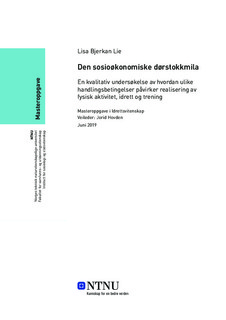| dc.description.abstract | Det har blitt gjennomført mange kvantitative studier på kjennetegn hos aktive og inaktive voksne, og hva som ser ut til å påvirke deltakelse av fysisk aktivitet, idrett og trening. Det er derimot mindre forskning på hvordan voksne opplever og erfarer hvilke ressurser som gir muligheter og begrensninger i forhold til deltakelse. I denne studien har jeg sett på hvordan aktive og inaktive voksne opplever muligheter og begrensninger for realisering av fysisk aktivitet i hverdagslivet. Oppgaven undersøker hvordan økonomiske, kulturelle og sosiale ressurser skaper handlingsrammer for deltakelse i fysisk aktivitet, idrett og trening.
Undersøkelsen er basert på et kvalitativt forskningsdesign, hvor datagrunnlaget er basert på intervjuer og hvor informantene har ulik sosioøkonomisk bakgrunn. Målet var å få kunnskap om hvordan informantene ser på sine handlingsbetingelser for å være fysisk aktive i hverdagen. Tidligere forskning har fungert som sammenligningsgrunnlag for de funnene som er gjort i datamaterialets analyse. Bourdieus (1984) praksisteori er dessuten studiens teoretiske utgangspunkt og rammeverket for datamaterialets analyse.
Studiens hovedfunn viser hvordan både muligheter og utfordringer for deltakelse er knyttet til informantenes økonomiske, kulturelle og sosiale ressurser, og hvordan disse gir ulike handlingsbetingelser for realisering/ikke realisering av fysisk aktivitet. Resultatene antyder tilstrekkelig økonomisk kapital som en inngangsbillett, og som en betingelse for å prioritere fysisk aktivitet i hverdagen. Dessuten viser datagrunnlaget hvordan økonomisk kapital gir større handlingsrom og flere valgmuligheter for å drive med fysisk aktivitet. Likevel viser studien også hvordan høy kulturell og sosial kapital fungerer som sentrale ressurser for det å være fysisk aktiv. Høy kulturell kapital ser i en viss grad ut til å kompensere for høy økonomisk kapital. Høy utdanningskapital kan tolkes som ressurs for å vektlegge en helseorientert livsstil. De som er aktive har også høy sosial kapital og et godt etablert nettverk. Likevel ser sosial kapital ut til å være av minst betydning for denne gruppen. Den ser derimot ut til å ha større betydning for de inaktive, som ser ut til å være mer avhengig av en aktiv omgangskrets for å kunne realisere fysisk aktivitet, idrett og trening i sin hverdag.
Nøkkelord: fysisk aktive og fysisk inaktive voksne, økonomiske/kulturelle/sosiale ressurser, handlingsbetingelser | |
| dc.description.abstract | A great number of quantitative studies have examined characteristics of active and inactive adults, and what appears to affect the participation of physical activity, sports and exercise. However, there is less research on how adults experience which resources provide opportunities and limitations in relation to participation. In this study, I have examined how active and inactive adults experience opportunities and limitations for accomplishment of physical activity in their everyday life. The thesis examines how economic, cultural and social resources create frameworks for participation in physical activity, sports and training.
The survey is based on a qualitative research design, where the data is based on interviews where the informants have different socioeconomic backgrounds. The goal was to gain knowledge about how the informants look at their conditions of action in order to be physically active in their everyday life. Previous research has also served as a basis for comparison for the findings that have been made in the data material analysis. Bourdieu's (1984) theory of practice is the study's theoretical starting point and the framework for the data material analysis.
The main findings indicate both opportunities and challenges for participation related to the informants' economic, cultural and social resources, and how these provide different conditions of action for accomplishment/non accomplishment of physical activity. The results suggest sufficient financial capital as an entry ticket and as a condition for prioritizing physical activity in everyday life. In addition, the data shows how economic capital provides greater room for maneuver and several choices for pursuing physical activity. Nevertheless, the study shows how high cultural and social capital functions as key resources for being physically active. High cultural capital appears to compensate for high economic capital in some extent. High education capital can be interpreted as a resource to emphasize a health-oriented lifestyle. Those who are active also have high social capital and a well-established network. Nevertheless, social capital seems to be of the least importance to this group. On the other hand, it appears to be of greater importance to the inactive, which appears to be more dependent on an active circle in order to accomplish physical activity, sports and training in their everyday lives.
Keywords: physical active and physical inactive adults, economical/cultural/social resources, conditions for physical exercise | |
